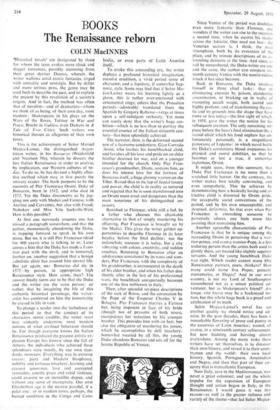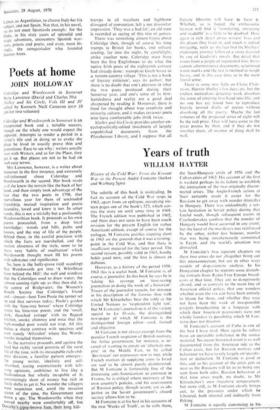BOOKS The Renaissance reborn
COLIN MacINNES
'Historical novels' are denigrated by those for whom the term evokes mere cloak and dagger romances, possibly stemming from their great deviser Dumas, wherein the writer wallows amid exotic fantasies, tinged with unreality and nostalgia. But by defter and more serious pens, the genre may be used both to describe the past, and to explain the present by this revelation of a society's origins. And in fact, the method was often that of novelists—and of dramatists—whom we think of as being, of their own day, most modern : Shakespeare in his plays on the Wars of the Roses, Tolstoy in War and Peace, Brecht in Galileo, even Dickens in A Tale of Two Cities. Such writers use historical themes as allegories of their own times.
This is the achievement of Senor Manuel Mujica-Lainez, the distinguished Argen- tinian writer, in his Bomarzo (Weidenfeld and Nicolson 50s), wherein he dissects the late Italian Renaissance in order to analyse, by implication, our Western cultures of to- day. To do so, he has devised a highly effec- tive method which may at first puzzle the unwary reader. The book purports to be the memoirs of Pier Francesco Orsini, Duke of Bomarzo, born in 1512, and who died in 1572. Yet the Duke disconcerts us by jug- gling not only with Medici and Farnese, with Aretino and Cervantes, but also with Freud, Nabokov and Miss Vita Sackville-West. How is this possible?
At first one nervously assumes one has missed a paragraph somewhere, and that the author, momentarily abandoning the Duke, is stepping forward to speak in his own name. But no, it is still Pier Francesco (dead for 400 years) who is talking to us. Later comes a hint that the Duke has made a Faus- tian pact with the devil, and is immortal; further on, another suggestion that a benign cabalistic elixir has assured him eternal life. But yet again, no: Bomarzo did die in 1572—by poison, in appropriate high Renaissance style. How come, then? The answer finally turns out to be that the Duke and the writer are the same person : or rather, that by imagining the life of this authentic historical personage, the writer- artist has conferred on him the immortality he craved in life in vain.
To plunge a reader into the turbulence of this period so that the conduct of its characters seems credible, the writer must first violently undermine most modern notions of what civilised behaviour should be. For though everyone knows the Italian Renaissance produced the greatest artistic ex- plosion Europe has known since the fall of Athens, the individuals who achieved these splendours were mostly, by our own stan- dards, monsters. Everything was in extreme excess: piety and blackest blasphemy, nobility and tortuous treacheryjearning and crassest ignorance, love and corrupted sensuality, courtly grace and rabid violence, could co-exist to an incredible degree, and without any sense of incongruity. Our own Elizabethan age is the nearest parallel, if a paler one : or in modern times, perhaps, the human condition in the Congo and Cam-
bodia, or even parts of Latin America itself.
To evoke this astounding era, the writer deploys a profound historical imagination, massive erudition, a vivid period sense of character, and a lapidary, if somewhat hyp- notic, style. Some may find that if Senor Mu- iica-Lainez wears his learning lightly as a glove, this is rather over-encrusted with ornamental rings; others that the Proustian periods—admirably translated from the Spanish by Gregory Rabassa—verge at times upon a self-indulgent verbosity. Yet none can surely deny that the writer's huge am- bition—which is no less than to portray the essential essence of the Italian sixteenth cen- tury—has been splendidly achieved.
The narrator, then, is the deformed second son of a fearsome condottiere. Gian Corrado Drsini, who loathes his hunchbacked child, and lavishes all his love and pride on an elder brother destined for war, and on a younger intended for the church. Only Pier Fran- cesco's grandmother, Diana, sustains him, as does his intense love for the fortress of Bomarzo itself, a huge gloomy warren on the Tiber. Raised thus in the lap of feudal luxury and power, the child is in reality so tortured and rejected that he is soon transformed into an Orsini more cruel and dangerous than the most notorious of his distinguished an- cestors.
Banished to Florence, while still a lad, by a father who chooses this charitable alternative to that cf simply murdering his offspring, Pier Francesco is brought up by the Medici. This gives the writer golden op- portunities to describe Florence in its later heyday before the final decline: not the melancholy museum it is today, but a city vibrating with colour, creativity, and sudden cruelties. Returning to Bomarzo after an adolescence sensational by its woes and won- ders, Pier Francesco, with the complexity of his grandmother, is instrumental in the death of his elder brother, and when his father dies shortly after in the last of his professional wars, the hunchback unexpectedly becomes one of the first noblemen in Italy.
Then, after splendid set-piece descriptions of the sack of Rome, and the coronation by the Pope of the Emperor Charles V in Bologna, Pier Francesco marries a Farnese but, being impotent in face of his bride (though not of peasants of both sexes), manipulates her seduction by his younger brother. This provides him with an heir, but also the obligation of murdering his junior, which he accomplishes by deft treachery. Somewhat wearied by all this, the young Duke abandons Bomarzo and sets off for the Serene Republic of Venice. Since Venice of the period was doubtless even more fantastic than Florence, one wonders if the writer can rise to the occasion a second time, when he escorts his reader across the Adriatic. One need not fear: the Venetian section is, I think, the most
triumphant, both by its evocation of the place, and by minute descriptions of its as- tounding denizens at the time. And since, as will be remembered, the Duke-writer are one and the same, the author can compare six- teenth century Venice with the tourist-ridden wreck it has since become.
Back in Bomarzo, the Duke involv es himself in three chief tasks : that of eliminating enemies by poison, clandestine assassination, or bricking up in walls; of mastering occult magic, both sacred and
highly profane; and of transforming the cas-
tle and its grounds into the shape they have more or less today—the first sight of which, in 1958. gave the writer the notion for his subsequent creation. The only remaining set- piece before the hero's final elimination (by a sacred elixir which his fond nephew has un- fortunately poisoned), is a magnificent panorama of Lepanto: in which naval battle the Duke's condottiere blood overcomes his physical and moral debilities, so that he becomes at last a true, if somewhat inglorious, Orsini.
It might seem, from this summary, that Duke Pier Francesco is no more than a wretched little horror. On the contrary, the writer makes him totally convincing, and even sympathetic. This he achieves by
demonstrating how a basically loving and at-
tractive child is distorted by Orsini pride, the acceptable social conventions of the period, and by his own unacceptable, and despised, deformity. So that even when Pier Francesco is entombing someone he perversely adores, one feels more like assisting than restraining him.
Another agreeable characteristic of Pier Francesco is that he is unique among the marauding Orsini in perceiving that a war- rior-prince, and even a warrior-Pope, is a less enduring person than the artists both used to glorify them, yet treated like slightly superior servants. And the young hunchback Duke was right. Which reader cannot name fifty Renaissance painters, poets, thinkers? How many could name five Popes, princely mercenaries, or Doges? And in our own country, is not my Lord of Southampton remembered not as a minor political ad- venturer, but as Shakespeare's friend? Ars
longa, vita brevis may be a hackneyed no- tion, but this whole huge book is a proof and celebration of its truth.
Seiior Mujica-Lainez's novel has yet another quality we should notice and ad- mire. In the past decades, there has been a remarkable flowering of prose and poetry in the countries of Latin America : rooted, of course, in a nineteenth century achievement, but now budding and bursting almost everywhere. Among the many tasks these writers have set themselves, is to discover their own history, and reveal it to their coun- trymen and the world : their own local history, Spanish, Portuguese, Amerindian and Negro, and then that part of their an- cestry that is transatlantic European.
Now Italy, save in the Mediterranean, was never a great coloniser; and yet the whole impulse for the expansion of European thought and action began in Italy, in the Renaissance. I would guess it was this reason—as well as the greater richness and variety of the theme—that led Sefior Mujica-
LaMez, as Argentinian, to choose Italy-for his subject, and not Spain. Not that, in his novel, we do not meet Spaniards enough: for the Duke, in his sixty years of splendid and tragic adventure, encounters Spanish war- riors, priests and poets; and even, most fit- tingly, the conquistador who founded Buenos Aires.































 Previous page
Previous page